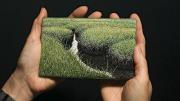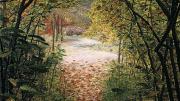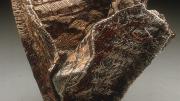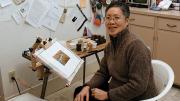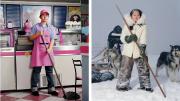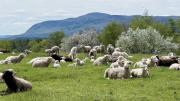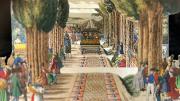From a distance, they look like framed four-by-six-inch color photographs of landscapes and still-life subjects—salt marshes, fountains, rocks, squashes. Come closer, and they are revealed as three-dimensional images rendered in intricate embroidery. In fact, these miniatures by Linda Liu Behar ’68 combine photography and fabric art. Behar begins each piece by printing one of her own photographs on cotton broadcloth. Then, with lapidary care, she stitches the forms, lines, colors, and light of the photo directly onto the underlying picture with colored threads. This makes for sharp realism—“photorealism,” if you will—and produces a captivating piece of fiber art. Despite their small size, each work can take four to six weeks to complete. Yet with embroidery, “the repetitiveness is sort of meditative,” Behar says. “I enjoy making the image come alive in the stitching.”
Behar has been crafting these tiny gems (the largest is seven inches by nine) since 1992, building on a prior decade of making large contemporary-art designs in the form of quilts. Apart from one other fiber artist in Colorado, who works entirely on a sewing machine, Behar is the only person making such photorealistic objects. Her work has appeared in many solo and group exhibitions, including one in 2002 at Boston’s Museum of Fine Arts, and has been featured in dozens of articles. The Mobilia Gallery in Cambridge (www.mobilia-gallery.com) represents her; the miniatures sell for several thousand dollars apiece. “With a draftsman’s command of form,” wrote American Craft magazine in 1998, “she creates exquisite, tiny windows on the natural world.”
A serious photographer since her high-school days in Northern California, Behar starts with a vivid image. “It has taken me all these years to realize that if I want to do a good embroidery, it has to be based on a good photograph,” she explains. With the salt marshes, for example (she has done 18 salt-marsh embroideries since 1997, each from a different image), “I had to consider the time of day, lighting conditions, the weather, the tides,” she says. “It’s making a photograph, not taking a photograph.” Sometimes, she manipulates the image digitally.
The next step is to stiffen the white fabric by sticking it to contact paper, which allows her to print a color photo image onto it with an ink-jet printer. She uses inks containing pigments, not water-soluble dyes. “Unlike dyes, these pigments don’t run when they get wet, or fade over time,” she explains. After removing the adhesive paper, Behar typically stitches one or more layers of appropriately colored thread onto the image, initially by using a computer-controlled sewing machine.
She uses the same perspective devices that landscape painters do to achieve the illusion of three dimensions: areas in the far distance are smaller, have less detail, and show more muted colors than those in the foreground. In the salt-marsh embroideries particularly, the built-up thickness of the thread enhances the 3-D illusion. “The threads do have dimension,” Behar says, “and where they are stitched thickly, the bulk of the land forms comes forward from the surface of the embroidery, while the stitches depicting water lie flat against the surface.” The computerized embroidery machine does the tedious work of accumulating a thickness of thread in the simple areas of color. Then Behar hand-stitches over the machined work, “covering it almost completely with nuanced colors and carefully angled stitching.”
By combining different colors of thread and embroidery floss (a softer, thicker, more lustrous type of cotton filament), Behar constructs her fiber images in a Seurat-like pointillist manner, mixing bits of color to achieve an overall impression. (Although she has tried painting, she says, “Paint and I do not get along. I can make thread go where I want it to go, but paint seems to have a mind of its own.”) In some ways, her stitching does resemble brushstrokes. In the salt-marsh embroideries, Behar creates the grasses with vertical stitches and uses horizontal ones for the water: “They work against each other.”

Courtesy Linda Liu Behar
In Quarry (1997), one of Behar's rare "sculptural" works, viewers can see stitching on both inner and outer surfaces.
Occasionally, Behar produces a work that literally occupies three dimensions, like Quarry (1997)—a kind of sculptural vessel in which both inner and outer surfaces are visible. “When people look at works in progress, they like to flip them over to see the stitching on the back,” Behar says. “This piece was a more organic way of showing the ‘back’ side as well as the front.”
Behar created her hybrid art form on her own, though it grew from experiences with a variety of visual media. At Radcliffe, she was a staff photographer for the Harvard Yearbook and sold photographs to the Radcliffe News Office for five dollars apiece. She concentrated in architectural sciences, “the only visual major Harvard offered,” she says. “It was the only place where you could get your hands dirty and make things.” As a senior, she took a graphic design course and “realized I had been doing that all along,” she recalls.
After college, she worked for several years as a graphic designer at a downtown Boston firm. She married Ken Behar, and became a full-time mother when Katherine, the first of her two children, was born. Behar took up quilting in 1983, when her son, Jonathan, was small, and soon her abstract/contemporary design quilts were appearing in shows, books, and magazines. “Quilts were in the air, beginning in the late 1970s,” Behar says. “The [1976] Bicentennial brought antique quilts to the forefront, and soon people were using the old techniques for new purposes. I really enjoyed working with fabric and thread.” A 1992 trip to Arizona with “a lot of visual input” inspired her to create a fabric memento in the form of a postcard, using appliqué with a little stitching on top. Before long, the stitching grew in importance, and she had begun creating her postcard-sized embroideries.
The pleasure hasn’t worn off. Behar explains that, despite the intricate, detailed work, “It’s not something I have to be patient about—it’s just an activity I enjoy. There’s something magical about it.”
